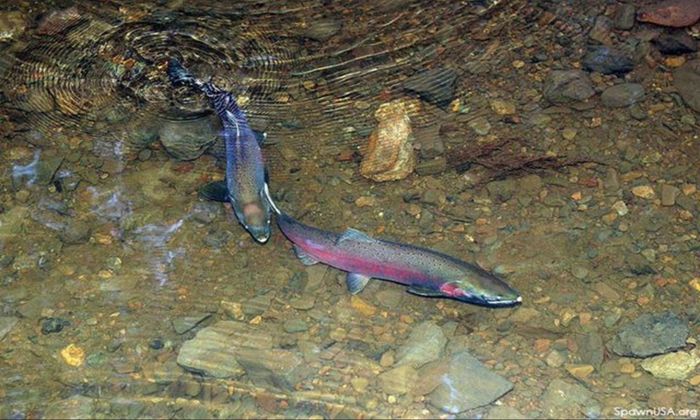Chinook vs. Coho: What’s the Difference?
Learn what to look out for when telling chinook and coho salmon apart with this quick guide.

Salmon are some of the most highly sought-after fish species in North America. There are currently six types of salmon known to anglers in the US, classified as Pacific or Atlantic salmon. The chinook, coho, sockeye, pink, and chum salmon species can be found in the Pacific Ocean or on the west coast, while only one, known as the atlantic salmon, lives on the other side of the coast.

Of all these salmon species, the chinook or king salmon and the coho or silver salmon are the most popular among anglers because they’re the most commonly caught. The king salmon are more widespread and can be acquired from Southern California all the way to Alaska. They can even be found in the Great Lakes. Silver salmon are mostly up north and can be found in the North Pacific area, Oregon, Washington, and the Great Lakes.
Looking at the two fish side by side, you can easily identify their distinguishing features. However, that is not the case when you’re on a boat hoping to land one. You can confuse one over the other because they share plenty of similarities, especially at first glance.

Still, it’s important to properly identify one over the other, especially in areas with restrictions on which fish are legal to catch during particular seasons. These regulations, after all, are put in place to help keep the populations of both well-loved fish species healthy and intact for years to come.
In this article, you’ll learn about the physical differences between coho salmon and chinook salmon, which will help you identify each fish species correctly, along with characteristics you cannot use when distinguishing between species.
Which Characteristics Can You Use to Distinguish Coho and Chinook?
1. Lower Jaw Coloration
The lower jaw of any salmon species, not just coho, and chinook, is the best feature to look at when making an identification. Most enforcers will look at this feature as well to determine whether you’ve properly identified a species or not.
Look at the coloration on the lower jaws to differentiate a coho from a chinook. Both fish species will have black mouths, but the coho salmon is known for the banding pattern on its lower jaw. The outside and inside of its tooth base look like dark bands, while the actual bottom has a very lightly colored, almost white band. Chinook salmon have mostly dark coloration in their lower jaw that can sometimes appear mottled but are often just evenly colored throughout.
2. Spots on the Back and Tail
Both the coho and chinook salmon can have spots on their bodies. When it does have its round spots, the chinook salmon will have them on the upper and lower parts of their tails across the back. On the other hand, the coho salmon will only have them on the top or upper lobe of its tail or, occasionally, both lobes. It can also have small spots on the back.
Another way to distinguish the chinook and coho based on the appearance of their backs is that the chinook can also have wavy spots on the back.

3. Tail Fin Ray and Anal Fin Ray
Anglers can tell coho and chinook salmon apart by touching the bone segments in their tail fin ray. The proper way to do this is by lightly running a fingernail atop the fin ray of the fish. If you can feel the bone, it’s a coho salmon. If you cannot feel the bone segments, then it’s a chinook salmon.
The anal fin rays of both species are often overlooked but can also be good distinguishing marks. The coho salmon’s anal fin ray is on the longer side, while the chinook salmon will still be long but will not extend over two-thirds of the fin base length.
4. During Spawning Season
Distinguishing between salmon species gets easier in spawning mode because their appearances transform quite drastically. A spawning chinook salmon has longer heads and mouths, with bodies and tails turning maroon or olive-brown. On the other hand, a spawning coho salmon will look maroon or almost bright red, with its head, back, and tail turning dark.
Which Characteristics Can You NOT Use to Distinguish Coho and Chinook?
1. Body Color for Ocean-Caught Fish
While the colors of both species can get altered in fresh water, they stay primarily silver when still in the ocean. They will have a few distinguishing marks and differences in shade, but they will most likely be predominantly silver, which is why experts advise against using color for ocean-caught fish.
2. Hooked Nose
The hooked nose is most commonly associated with spawning male coho salmon. Still, it can appear as a secondary sexual characteristic of many male salmon species heading towards maturity and spawning age.
3. Size
Chinook are called kings for a reason - they’re the largest salmon species in North America. Coho, on the other hand, doesn’t grow quite as big as the biggest chinook. However, it is common for anglers to see coho in the 25-30 lbs range, while an ocean-caught chinook will weigh 12 to 15 lbs on average. So if you use size alone to distinguish one species from another, you could easily be mistaken given their average caught sizes.
A tip: Handle your fish properly upon catching it because if you still cannot identify it, experts advise anglers to release it back into the water. Having misidentified fish will not only result in its confiscation but could land you a huge fine.



